A short-term target for a little more downwards movement was at 2,981. The low for Monday has reached 2,990.67. Members were warned that the short-term target may have been a little too low.
Summary: The upwards trend may now resume to new all time highs.
The next target is 3,120. Classic analysis very strongly supports this main wave count.
The biggest picture, Grand Super Cycle analysis, is here.
Monthly charts were last published here, with video here. There are two further alternate monthly charts here, with video here.
ELLIOTT WAVE COUNTS
The two weekly Elliott wave counts below will be labelled First and Second. They may be about of even probability. When the fifth wave currently unfolding on weekly charts may be complete, then these two wave counts will diverge on the severity of the expected following bear market. To see an illustration of this future divergence monthly charts should be viewed.
FIRST WAVE COUNT
WEEKLY CHART
The basic Elliott wave structure consists of a five wave structure up followed by a three wave structure down (for a bull market). This wave count sees the bull market beginning in March 2009 as an incomplete five wave impulse and now within the last fifth wave, which is labelled cycle wave V. This impulse is best viewed on monthly charts. The weekly chart focusses on the end of it.
Elliott wave is fractal. This fifth wave labelled cycle wave V may end a larger fifth wave labelled Super Cycle wave (V), which may end a larger first wave labelled Grand Super Cycle wave I.
The teal Elliott channel is drawn using Elliott’s first technique about the impulse of Super Cycle wave (V). Draw the first trend line from the end of cycle wave I (off to the left of the chart, the weekly candlestick beginning 30th November 2014) to the end of cycle wave III, then place a parallel copy on the end of cycle wave II. This channel perfectly shows where cycle wave IV ended at support. The strongest portion of cycle wave III, the end of primary wave 3, overshoots the upper edge of the channel. This is a typical look for a third wave and suggests the channel is drawn correctly and the way the impulse is counted is correct.
Within Super Cycle wave (V), cycle wave III is shorter than cycle wave I. A core Elliott wave rule states that a third wave may never be the shortest. For this rule to be met in this instance, cycle wave V may not be longer in length than cycle wave III. This limit is at 3,477.39.
Cycle wave V may subdivide either as an impulse or an ending diagonal. Impulses are much more common. This main wave count expects that cycle wave V may be unfolding as an impulse.
The daily chart below will now focus on all movement from the end of primary wave 2.
In historic analysis, two further monthly charts have been published that do not have a limit to upwards movement and are more bullish than this wave count. Members are encouraged to consider those possibilities (links below summary) alongside the wave counts presented on a daily and weekly basis.
DAILY CHART
Cycle wave V is seen as an impulse for this wave count.
Within cycle wave V, primary waves 1 and 2 may be complete. Primary wave 3 may have begun.
Primary wave 3 may only subdivide as an impulse. Within primary wave 3, intermediate waves (1) and (2) may be complete.
Intermediate wave (3) may have begun. Intermediate wave (3) may only subdivide as an impulse.
Within intermediate wave (3), minor waves 1 and 2 may be complete. Within minor wave 3, minute waves i and ii may be complete. Within minute wave iii, minuette waves (i), (ii) and (iii) may be complete. It is also possible that within minute wave iii, only minuette wave (i) may be nearing completion. For this reason the invalidation point is left at the same point. Within minute wave iii, no second wave correction may move beyond its start below 2,834.97.
All of primary wave 3, intermediate wave (3), minor wave 3 and minute wave iii may only subdivide as impulses.
Intermediate wave (3) must move far enough above the end of intermediate wave (1) to then allow intermediate wave (4) to unfold and remain above intermediate wave (1) price territory.
HOURLY CHART
Within minute wave iii, minuette waves (i) through to (iv) may be complete. Minuette wave (iii) is just 0.61 points longer than 2.618 the length of minuette wave (i).
If it continues further, then minuette wave (iv) may not move into minuette wave (i) price territory below 2,898.79.
Minuette wave (ii) was a deep 0.72 zigzag lasting 8 hours. Minuette wave (iv) may be a more shallow zigzag lasting 14 hours and showing up on the daily chart as two candlesticks. There is alternation in depth although both corrections are the same structure: there is alternation between them in that minuette wave (ii) has a long subminuette wave a and a short subminuette wave c while minuette wave (iv) has a short subminuette wave a and a long subminuette wave c.
At 3,054 minuette wave (v) would reach equality in length with minuette wave (i).
SECOND WAVE COUNT
WEEKLY CHART
This weekly chart is almost identical to the first weekly chart, with the sole exception being the degree of labelling.
This weekly chart moves the degree of labelling for the impulse beginning in March 2009 all down one degree. This difference is best viewed on monthly charts.
The impulse is still viewed as nearing an end; a fifth wave is still seen as needing to complete higher. This wave count labels it primary wave 5.
TECHNICAL ANALYSIS
WEEKLY CHART
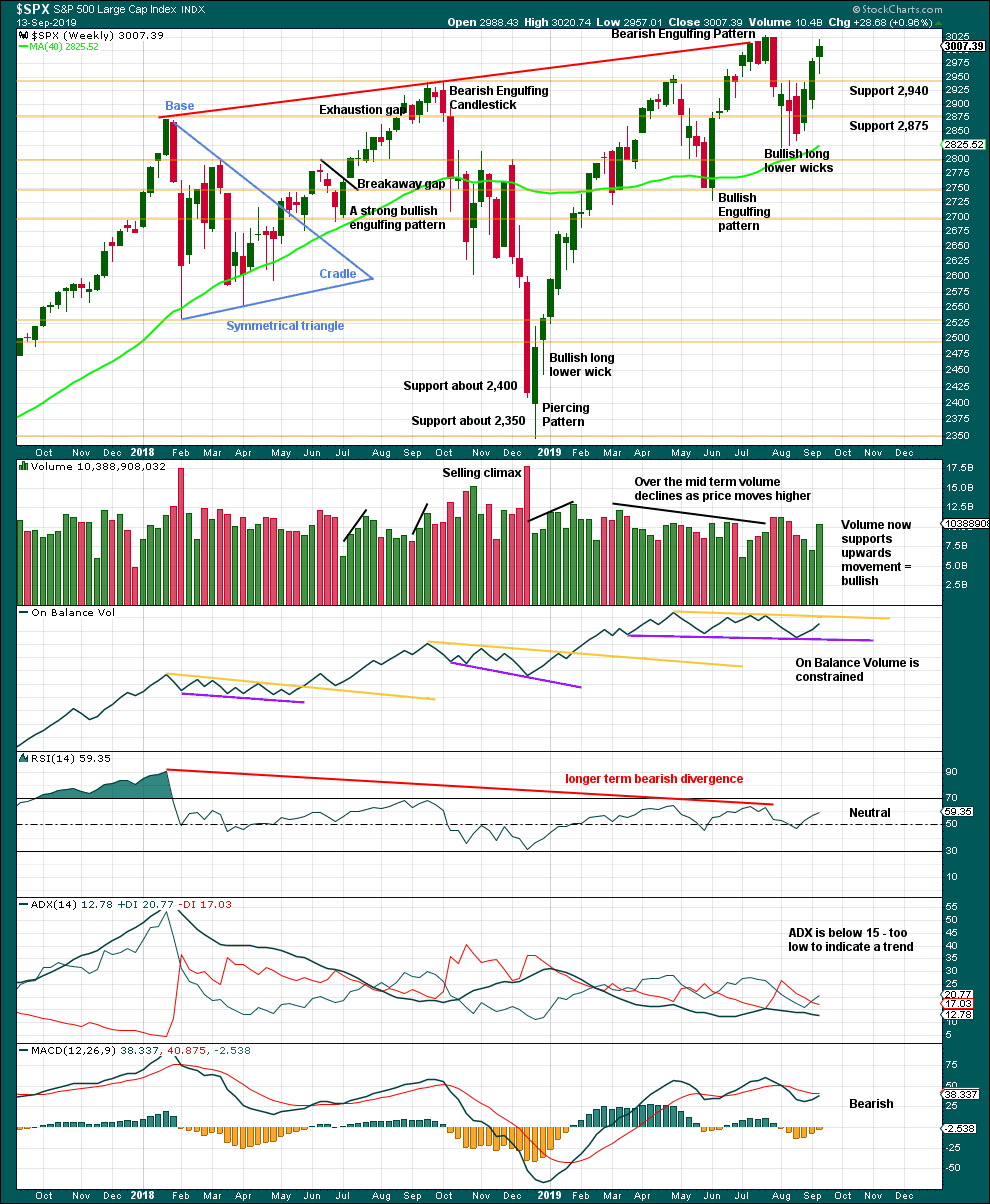
Click chart to enlarge. Chart courtesy of StockCharts.com.
A long lower wick and good support from volume for an upwards week strongly suggests more upwards movement directly ahead.
DAILY CHART
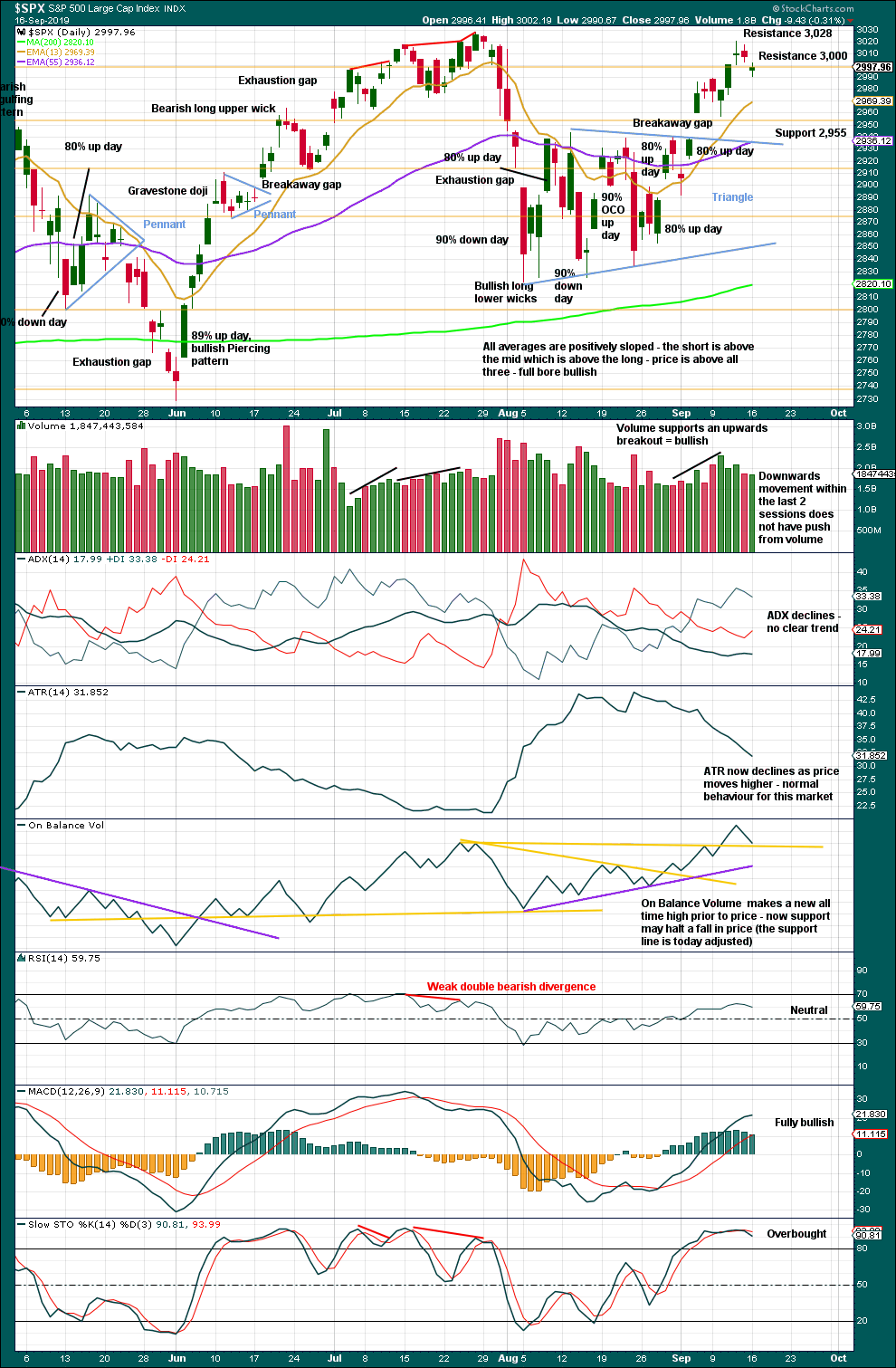
Click chart to enlarge. Chart courtesy of StockCharts.com.
The last low of the 15th of August was preceded immediately by a 90% downward day and followed immediately by a 90% OCO (Operating Companies Only) up day. This is a pattern commonly found at major lows, and it indicates a 180 degree shift in sentiment from bearish to bullish. This supports the Elliott wave count.
Now the next low of the 23rd of August has been followed by two back to back 80% up days. This too is very bullish and favours the main Elliott wave count.
There is now an upwards breakout above the triangle pattern with support from volume and a breakaway gap. The breakaway gap may offer support at 2,938.84.
A target from the triangle pattern is 3,060.
Support about 3,000 has been broken but not by much. Downwards movement within this last session is very weak, with up volume dominating total up / down volume and advances dominating advances / declines, from Lowry’s data. This still looks like a small pullback within an ongoing upwards trend.
The short-term volume profile, On Balance Volume, and the chart pattern of the triangle all strongly support the Elliott wave count. This trend has further room to move before RSI again reaches into overbought.
BREADTH – AD LINE
WEEKLY CHART
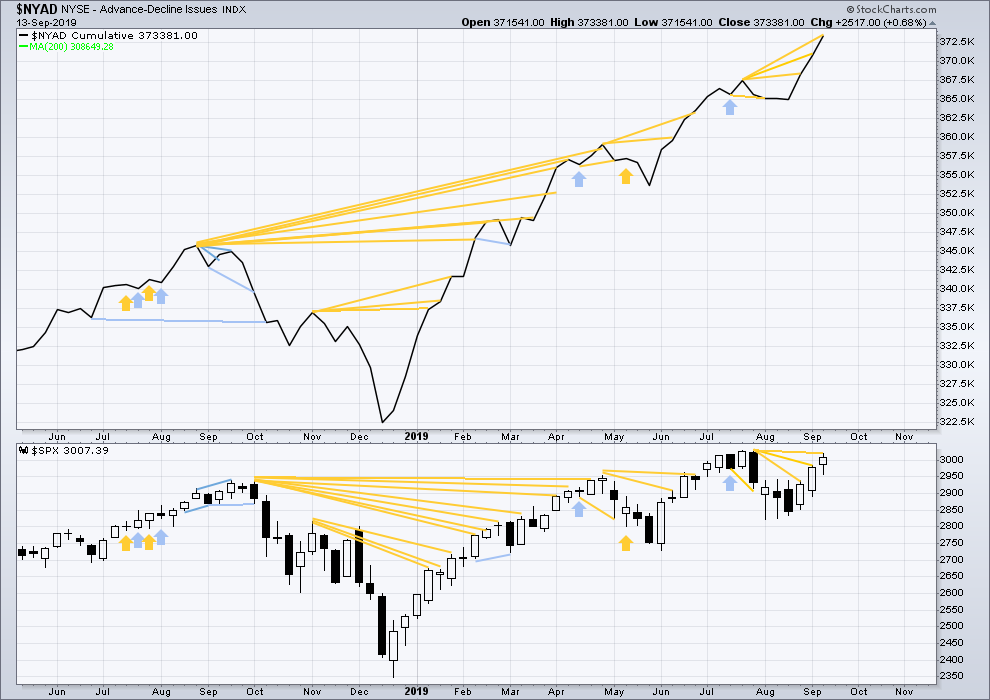
Click chart to enlarge. Chart courtesy of StockCharts.com. So that colour blind members are included, bearish signals
will be noted with blue and bullish signals with yellow.
Bear markets from the Great Depression and onwards have been preceded by an average minimum of 4 months divergence between price and the AD line with only two exceptions in 1946 and 1976. With the AD line making new all time highs again this week, the end of this bull market and the start of a new bear market is very likely a minimum of 4 months away, which is mid January 2020.
In all bear markets in the last 90 years there is some positive correlation (0.6022) between the length of bearish divergence and the depth of the following bear market. No to little divergence is correlated with more shallow bear markets. Longer divergence is correlated with deeper bear markets.
If a bear market does develop here, it comes after no bearish divergence. It would therefore more likely be shallow.
Again, last week both price and the AD line have moved higher.
The AD line makes a new all time high. This is a very bullish signal and very strongly supports the Elliott wave count.
Small caps have made a new swing high above the prior high of the end of July, but mid and large caps have not yet done so. This upwards movement of the last three weeks appears to be led by small caps. Because small caps are usually the first to exhibit deterioration in the later stages of a bull market, some strength in small caps at this stage indicates a healthy bull market with further to run.
DAILY CHART
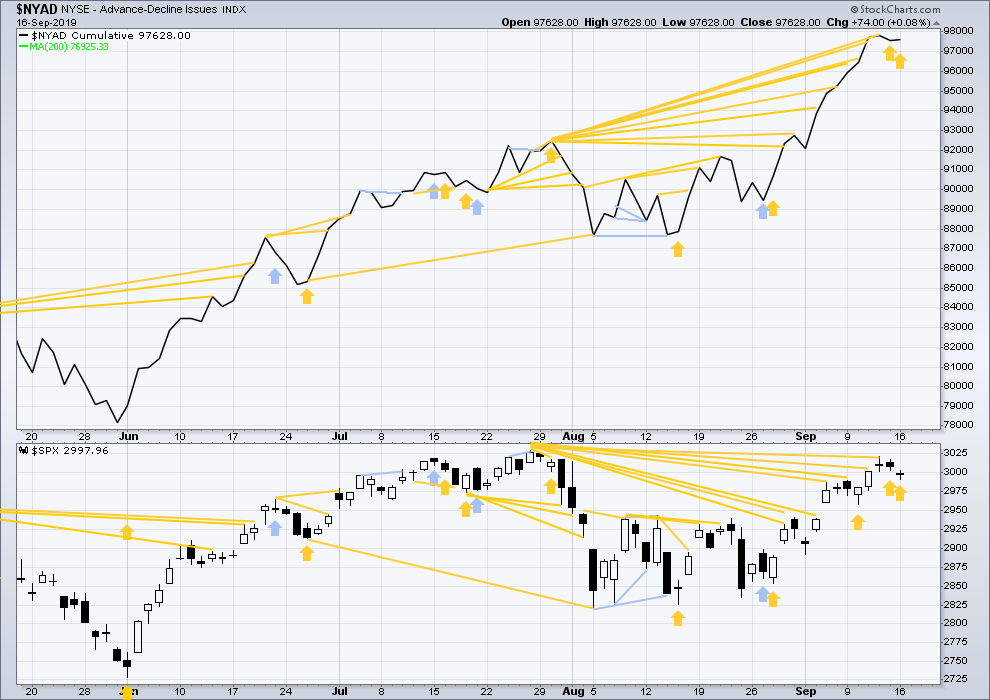
Click chart to enlarge. Chart courtesy of StockCharts.com. So that colour blind members are included, bearish signals
will be noted with blue and bullish signals with yellow.
Breadth should be read as a leading indicator.
Today price has moved a little lower, but the AD line appears to have moved higher. This divergence is bullish for the very short term and supports the view that the small pullback may be complete today.
VOLATILITY – INVERTED VIX CHART
WEEKLY CHART
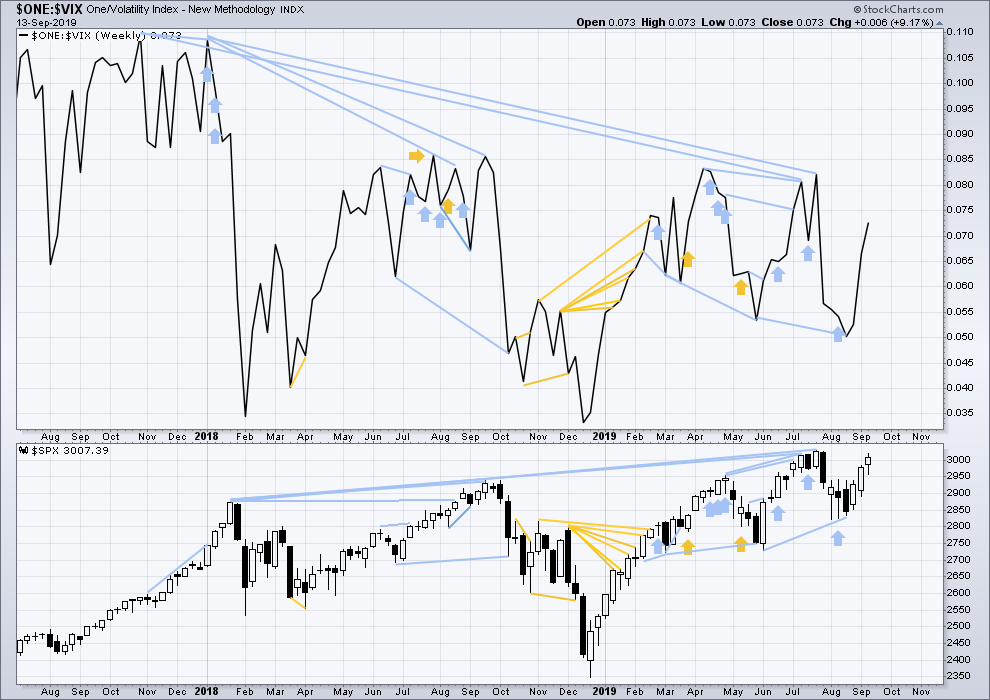
Click chart to enlarge. Chart courtesy of StockCharts.com. So that colour blind members are included, bearish signals
will be noted with blue and bullish signals with yellow.
The all time high for inverted VIX (which is the same as the low for VIX) was on 30th October 2017. There is now nearly one year and ten months of bearish divergence between price and inverted VIX.
The rise in price is not coming with a normal corresponding decline in VIX; VIX remains elevated. This long-term divergence is bearish and may yet develop further as the bull market matures.
This divergence may be an early warning, a part of the process of a top developing that may take years. It may not be useful in timing a trend change.
Again, last week both price and inverted VIX have moved higher. There is no new divergence.
DAILY CHART
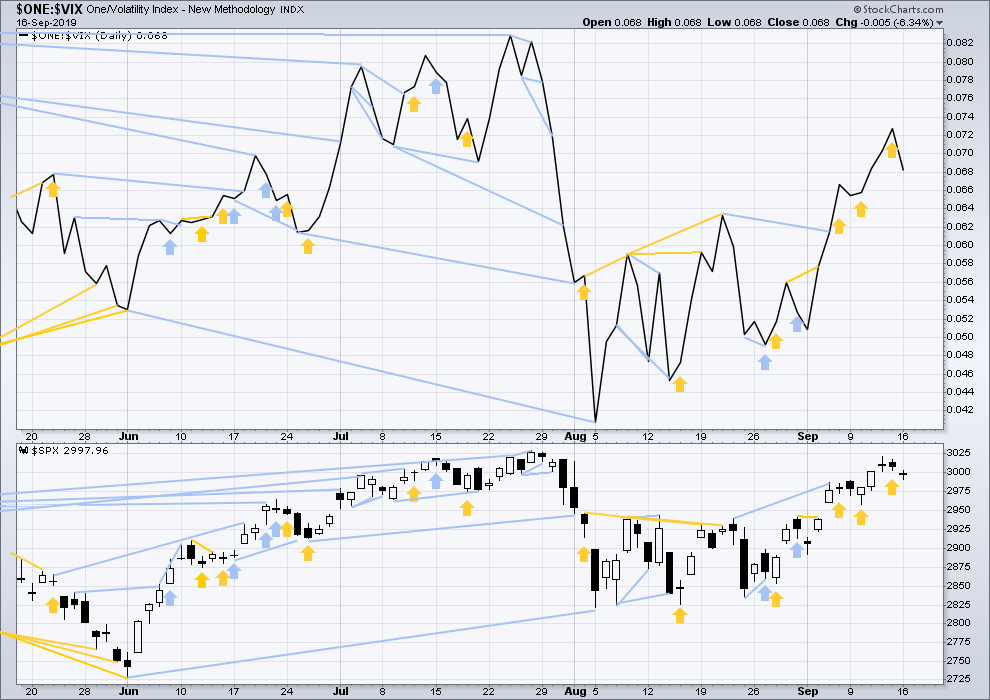
Click chart to enlarge. Chart courtesy of StockCharts.com. So that colour blind members are included, bearish signals
will be noted with blue and bullish signals with yellow.
Today both price and inverted VIX have moved lower. Neither have made new short-term swing lows. There is no new short-term divergence.
DOW THEORY
Dow Theory confirmed a bear market in December 2018. This does not necessarily mean a bear market at Grand Super Cycle degree though; Dow Theory makes no comment on Elliott wave counts. On the 25th of August 2015 Dow Theory also confirmed a bear market. The Elliott wave count sees that as part of cycle wave II. After Dow Theory confirmation of a bear market in August 2015, price went on to make new all time highs and the bull market continued.
DJIA: 23,344.52 – a close on the 19th of December at 23,284.97 confirms a bear market.
DJT: 9,806.79 – price has closed below this point on the 13th of December.
S&P500: 2,532.69 – a close on the 19th of December at 2,506.96 provides support to a bear market conclusion.
Nasdaq: 6,630.67 – a close on the 19th of December at 6,618.86 provides support to a bear market conclusion.
With all the indices having moved higher following a Dow Theory bear market confirmation, Dow Theory would confirm a bull market if the following highs are made:
DJIA: 26,951.81 – a close above this point has been made on the 3rd of July 2019.
DJT: 11,623.58 – to date DJT has failed to confirm an ongoing bull market.
S&P500: 2,940.91 – a close above this point was made on the 29th of April 2019.
Nasdaq: 8,133.30 – a close above this point was made on the 26th of April 2019.
Published @ 07:38 p.m. EST.
—
Careful risk management protects your trading account(s).
Follow my two Golden Rules:
1. Always trade with stops.
2. Risk only 1-5% of equity on any one trade.
—
New updates to this analysis are in bold.

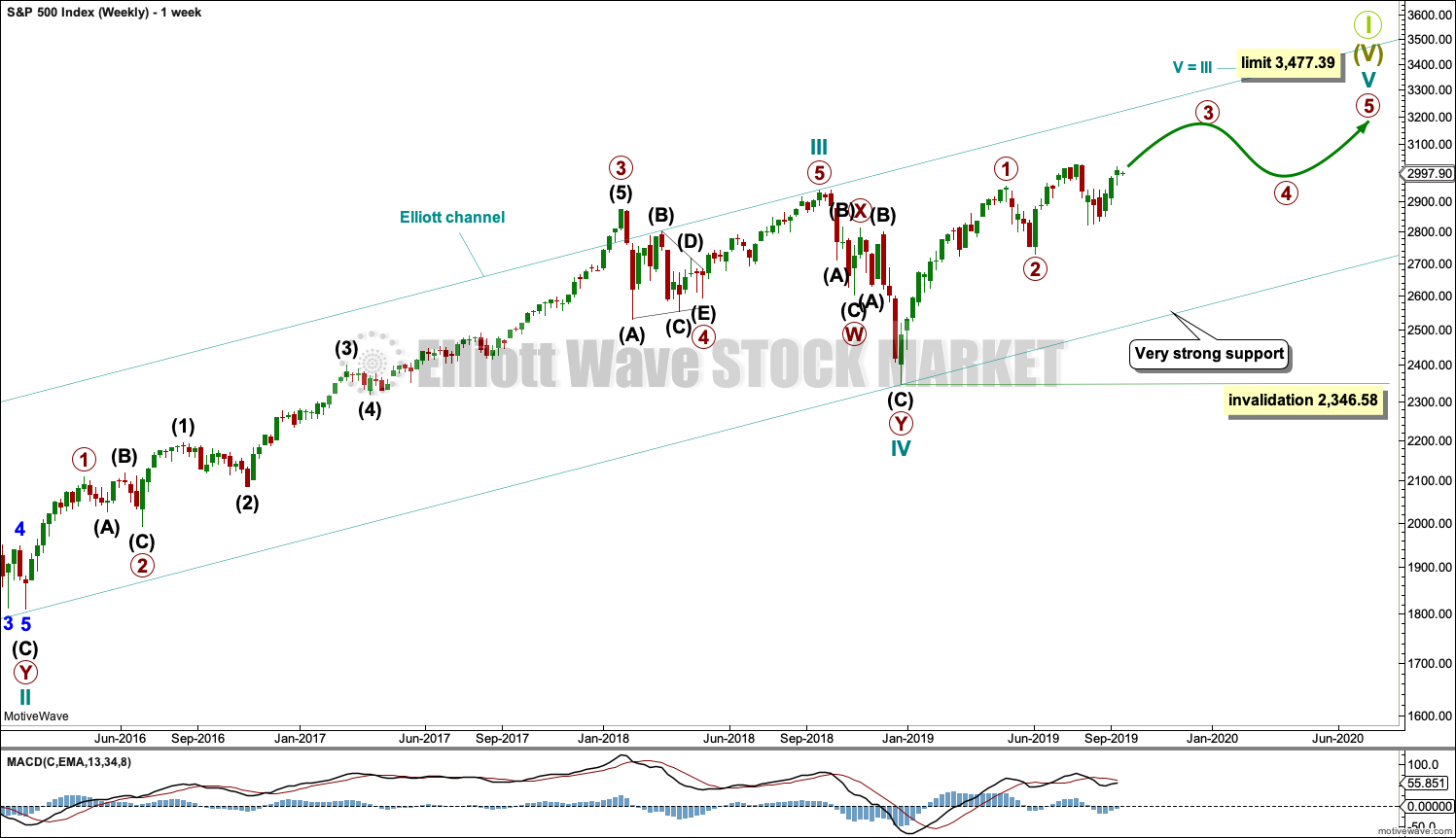
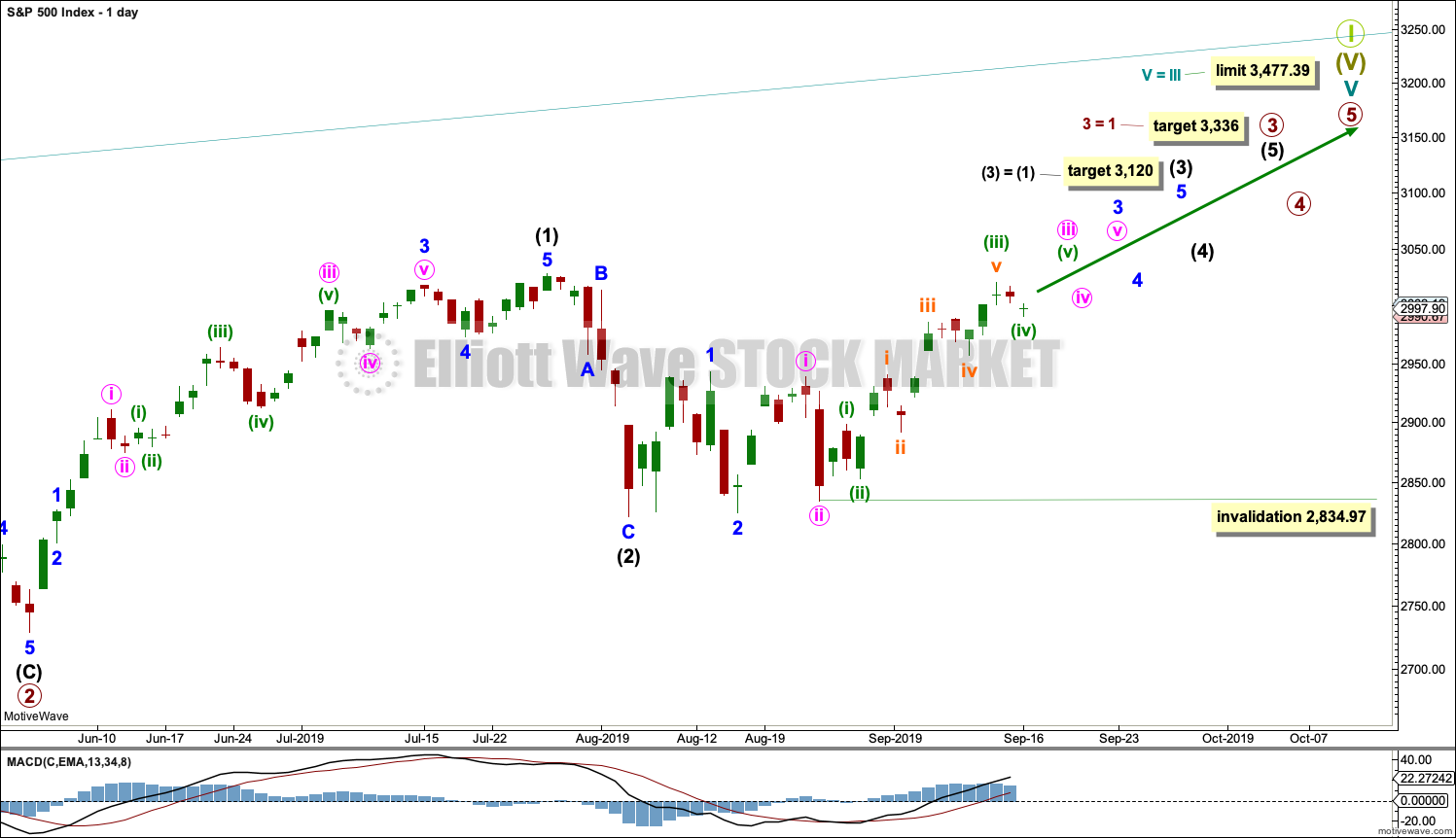
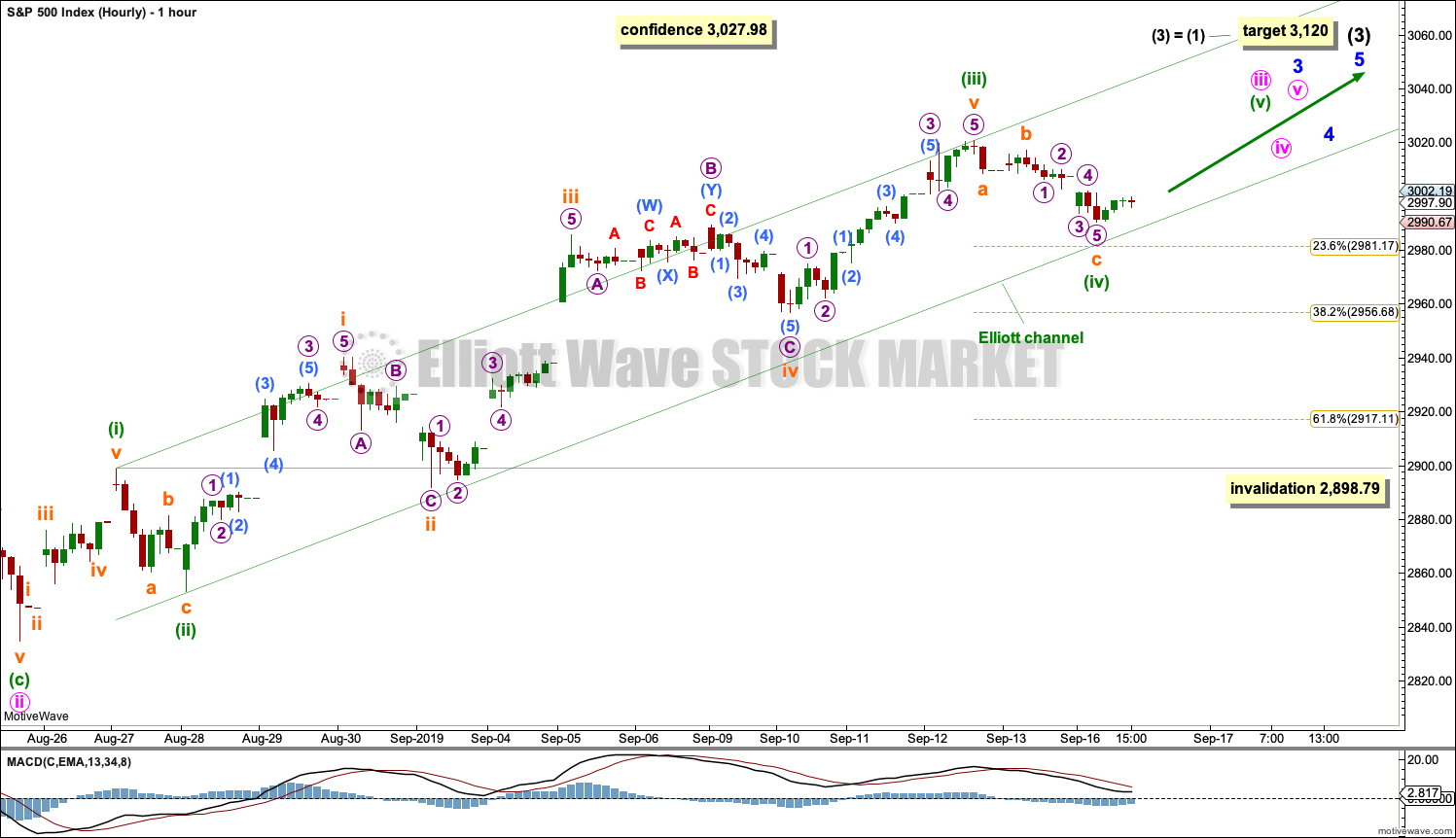
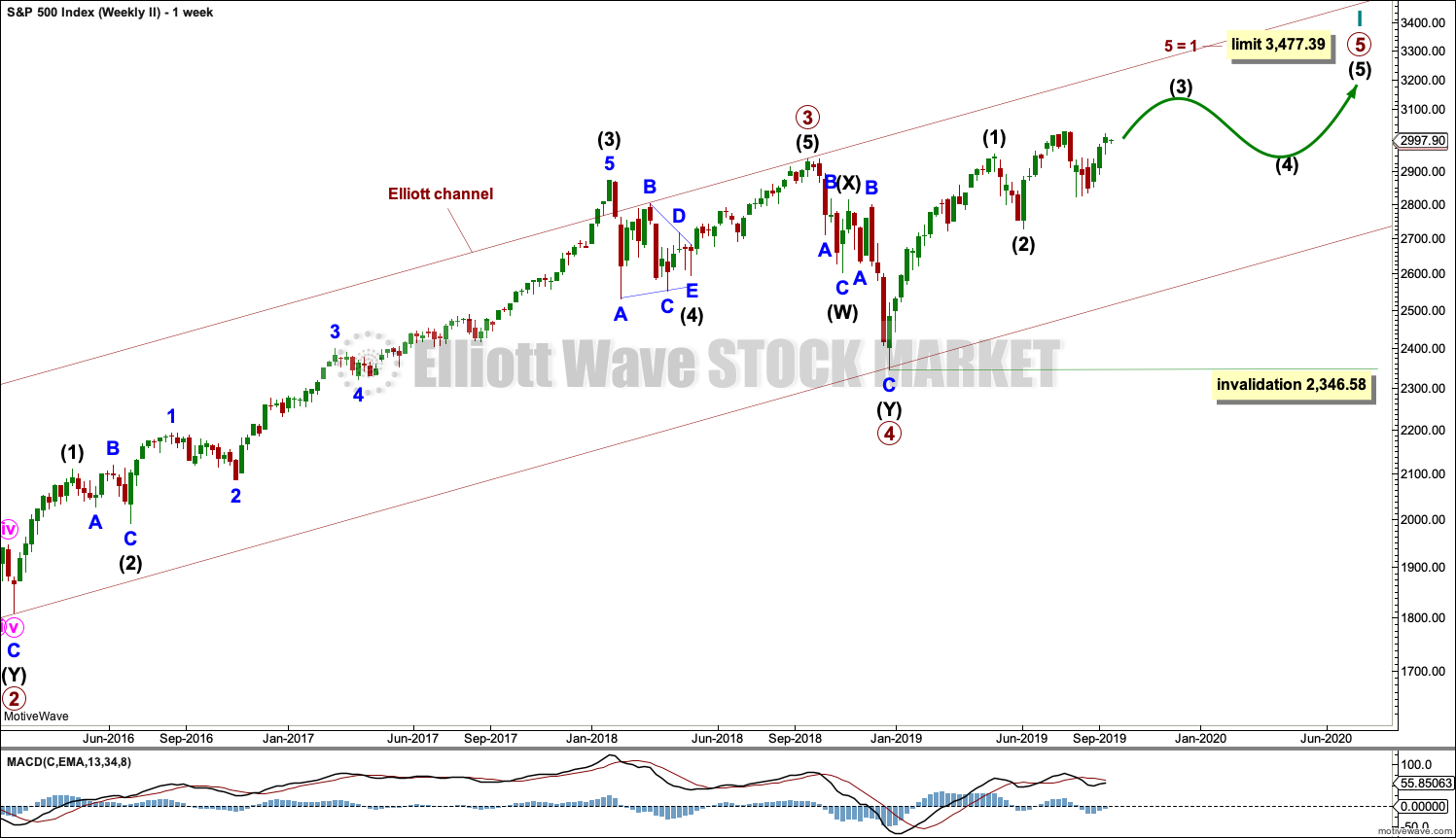
Hourly chart updated:
Price remains within the channel and support holds, so far.
trying to grok if and how much deeper SPX goes. So I’ve fitted fibonacci structures over the hourly action since the recent highs. The “degree of fit” tag count (pivots right at or very close to the Fibo levels) are shown for each level. I was able to find more levels, but the others had more like 4 or so tags, so I threw them out. These 3 stand out. I’ve left the tag markings and fibo structure in place for the deepest, which also has the largest tag count.
Gold has formed a double bottom. (GLD, it’s at 140.) I’ve put on an Oct bull debit spread 140-146. I’ll take my medicine if that double bottom is breached.
/ES four hour chart w/overnight data, more refined projections for the ultimate low of what’s shaping up so far as a simple zigzag minuette iv wave down. The green ovals are my projections, based on a combination of a fitted fibonacci structure to the price action so far, symmetric projections of prior down moves, the 1.26 and 1.61 extensions of the minuette a, and the level were minuette a = minuette c. Lots of those overlap, leading to these levels as targets: 2975, 2965, and 2957.
Could very well be.
My take on the hourly ES chart is that (iv) may be finished. Particularly when c of (iv) is only 0.75 points more than 2.618 times a of (iv).
If so then it looks like a series of 1s and 2s with wave 3 coming up soon.
But 2983.50 must hold if this scenario is correct.
The challenge that I see with that count Halpin isn’t the count. The “structure” of the upward movement looks extremely weak and very B-wave-ish to me. Classic bear flag look. We’ll see! I appreciate your alternative models, thanks.
My RUT daily view. If price breaks above the highs of today/yesterday, my market state variable goes back to trending and it’s pretty clear 1600 is the next high potential pivot level. And the hourly is set up for buy on that break out of these highs. But any falling price action takes my market state variable to topping phase 2 and it’s time to trigger in shorts. That’s my general plan anyway.
And my hourly take.
Y cannot be labelled as a multiple.
The maximum number of corrections in a multiple is three. This count applies to W, Y and Z. To label any one of W, Y or Z as a multiple would multiply the total beyond three and violate the rule.
This count does not apply to X waves, they’re joining structures and can be any corrective structure (otherwise the count would be 5, not 3)
Got it!
Drat! My cold streak continues…